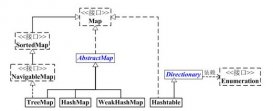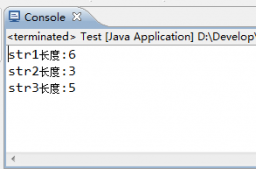iBatis 简介:
iBatis 是apache 的一个开源项目,一个O/R Mapping 解决方案,iBatis 最大的特点就是小巧,上手很快。如果不需要太多复杂的功能,iBatis 是能够满足你的要求又足够灵活的最简单的解决方案,现在的iBatis 已经改名为Mybatis 了。
1.输入参数为单个值
|
1
2
3
4
5
6
7
8
9
10
11
12
13
14
|
<delete id="com.fashionfree.stat.accesslog.deleteMemberAccessLogsBefore"parameterClass="long"> delete from MemberAccessLog where accessTimestamp = #value# </delete> <delete id="com.fashionfree.stat.accesslog.deleteMemberAccessLogsBefore"parameterClass="long"> delete from MemberAccessLog where accessTimestamp = #value# </delete> |
2.输入参数为一个对象
|
1
2
3
4
5
6
7
8
9
10
11
12
13
14
15
16
17
18
19
20
21
22
23
24
25
26
27
28
29
30
31
32
33
34
35
36
|
<insert id="com.fashionfree.stat.accesslog.MemberAccessLog.insert"parameterClass="com.fashionfree.stat.accesslog.model.MemberAccessLog> insert into MemberAccessLog ( accessLogId, memberId, clientIP, httpMethod, actionId, requestURL, accessTimestamp, extend1, extend2, extend3 ) values ( #accessLogId#, #memberId#, #clientIP#, #httpMethod#, #actionId#, #requestURL#, #accessTimestamp#, #extend1#, #extend2#, #extend3# ) </insert> <insert id="com.fashionfree.stat.accesslog.MemberAccessLog.insert"parameterClass="com.fashionfree.stat.accesslog.model.MemberAccessLog> insert into MemberAccessLog ( accessLogId, memberId, clientIP, httpMethod, actionId, requestURL, accessTimestamp, extend1, extend2, extend3 ) values ( #accessLogId#, #memberId#, #clientIP#, #httpMethod#, #actionId#, #requestURL#, #accessTimestamp#, #extend1#, #extend2#, #extend3# ) </insert> |
3.输入参数为一个java.util.HashMap
|
1
2
3
4
5
6
7
8
9
10
11
12
13
14
15
16
17
18
19
20
21
22
23
24
25
26
|
<select id="com.fashionfree.stat.accesslog.selectActionIdAndActionNumber"parameterClass="hashMap"resultMap="getActionIdAndActionNumber"> select actionId, count(*) as count from MemberAccessLog where memberId = #memberId# and accessTimestamp > #start# and accessTimestamp <= #end# group by actionId </select><select id="com.fashionfree.stat.accesslog.selectActionIdAndActionNumber"parameterClass="hashMap"resultMap="getActionIdAndActionNumber"> select actionId, count(*) as count from MemberAccessLog where memberId = #memberId# and accessTimestamp > #start# and accessTimestamp <= #end# group by actionId </select> |
4.输入参数中含有数组
|
1
2
3
4
5
6
7
8
9
10
11
12
13
14
15
16
17
18
19
20
21
22
23
24
25
26
|
<insert id="updateStatusBatch" parameterClass="hashMap"> update Question set status = #status# <dynamic prepend="where questionId in"> <isNotNull property="actionIds"> <iterate property="actionIds" open="(" close=")" conjunction=","> #actionIds[]# </iterate> </isNotNull> </dynamic> </insert> <insert id="updateStatusBatch" parameterClass="hashMap"> update Question set status = #status# <dynamic prepend="where questionId in"> <isNotNull property="actionIds"> <iterate property="actionIds" open="(" close=")" conjunction=","> #actionIds[]# </iterate> </isNotNull> </dynamic> </insert> |
说明:actionIds为传入的数组的名字; 使用dynamic标签避免数组为空时导致sql语句语法出错; 使用isNotNull标签避免数组为null时ibatis解析出错
5.传递参数只含有一个数组
|
1
2
3
4
5
6
7
8
9
10
11
12
13
14
15
16
17
18
19
20
21
22
23
24
25
26
27
28
|
<select id="com.fashionfree.stat.accesslog.model.StatMemberAction.selectActionIdsOfModule"resultClass="hashMap"> select moduleId, actionId from StatMemberAction <dynamic prepend="where moduleId in"> <iterate open="(" close=")" conjunction=","> #[]# </iterate> </dynamic> order by moduleId </select><select id="com.fashionfree.stat.accesslog.model.StatMemberAction.selectActionIdsOfModule"resultClass="hashMap"> select moduleId, actionId from StatMemberAction <dynamic prepend="where moduleId in"> <iterate open="(" close=")" conjunction=","> #[]# </iterate> </dynamic> order by moduleId </select> |
说明:注意select的标签中没有parameterClass一项
另:这里也可以把数组放进一个hashMap中,但增加额外开销,不建议使用
6.让ibatis把参数直接解析成字符串
|
1
2
3
4
5
6
7
8
9
10
11
12
13
14
15
16
17
18
19
20
21
22
|
<select id="com.fashionfree.stat.accesslog.selectSumDistinctCountOfAccessMemberNum"parameterClass="hashMap" resultClass="int"> select count(distinct memberId) from MemberAccessLog where accessTimestamp >= #start# and accessTimestamp < #end# and actionId in $actionIdString$ </select> <select id="com.fashionfree.stat.accesslog.selectSumDistinctCountOfAccessMemberNum"parameterClass="hashMap" resultClass="int"> select count(distinct memberId) from MemberAccessLog where accessTimestamp >= #start# and accessTimestamp < #end# and actionId in $actionIdString$ </select> |
说明:使用这种方法存在sql注入的风险,不推荐使用
7.分页查询 (pagedQuery)
|
1
2
3
4
5
6
7
8
9
10
11
12
13
14
15
16
17
18
19
20
21
22
23
24
25
26
27
28
29
30
31
32
33
34
35
36
37
38
39
40
41
42
43
44
45
46
47
48
49
50
51
52
53
54
55
56
57
58
59
60
61
62
63
64
65
66
67
68
69
70
71
72
73
74
75
76
|
<select id="com.fashionfree.stat.accesslog.selectMemberAccessLogBy"parameterClass="hashMap" resultMap="MemberAccessLogMap"> <include refid="selectAllSql"/> <include refid="whereSql"/> <include refid="pageSql"/> </select> <select id="com.fashionfree.stat.accesslog.selectMemberAccessLogBy.Count"parameterClass="hashMap" resultClass="int"> <include refid="countSql"/> <include refid="whereSql"/> </select> <sql id="selectAllSql"> select accessLogId, memberId, clientIP, httpMethod, actionId, requestURL, accessTimestamp, extend1, extend2, extend3 from MemberAccessLog </sql> <sql id="whereSql"> accessTimestamp <= #accessTimestamp# </sql> <sql id="countSql"> select count(*) from MemberAccessLog </sql> <sql id="pageSql"> <dynamic> <isNotNull property="startIndex"> <isNotNull property="pageSize"> limit #startIndex# , #pageSize# </isNotNull> </isNotNull> </dynamic> </sql><select id="com.fashionfree.stat.accesslog.selectMemberAccessLogBy"parameterClass="hashMap" resultMap="MemberAccessLogMap"> <include refid="selectAllSql"/> <include refid="whereSql"/> <include refid="pageSql"/> </select> <select id="com.fashionfree.stat.accesslog.selectMemberAccessLogBy.Count"parameterClass="hashMap" resultClass="int"> <include refid="countSql"/> <include refid="whereSql"/> </select> <sql id="selectAllSql"> select accessLogId, memberId, clientIP, httpMethod, actionId, requestURL, accessTimestamp, extend1, extend2, extend3 from MemberAccessLog </sql> <sql id="whereSql"> accessTimestamp <= #accessTimestamp# </sql> <sql id="countSql"> select count(*) from MemberAccessLog </sql> <sql id="pageSql"> <dynamic> <isNotNull property="startIndex"> <isNotNull property="pageSize"> limit #startIndex# , #pageSize# </isNotNull> </isNotNull> </dynamic> </sql> |
说明:本例中,代码应为:
|
1
2
3
|
HashMap hashMap = new HashMap(); hashMap.put(“accessTimestamp”, someValue); pagedQuery(“com.fashionfree.stat.accesslog.selectMemberAccessLogBy”, hashMap); |
pagedQuery方法首先去查找名为com.fashionfree.stat.accesslog.selectMemberAccessLogBy.Count 的mapped statement来进行sql查询,从而得到com.fashionfree.stat.accesslog.selectMemberAccessLogBy查询的记录个数, 再进行所需的paged sql查询(com.fashionfree.stat.accesslog.selectMemberAccessLogBy),具体过程参见utils类中的相关代码
8.sql语句中含有大于号>、小于号< 1. 将大于号、小于号写为: > < 如:
|
1
2
3
4
5
6
7
8
9
10
11
12
13
|
<delete id="com.fashionfree.stat.accesslog.deleteMemberAccessLogsBefore" parameterClass="long"> delete from MemberAccessLog where accessTimestamp <= #value# </delete> Xml代码 <delete id="com.fashionfree.stat.accesslog.deleteMemberAccessLogsBefore" parameterClass="long"> delete from MemberAccessLog where accessTimestamp <= #value# </delete> |
将特殊字符放在xml的CDATA区内:
|
1
2
3
4
5
6
7
8
9
10
11
12
13
14
15
16
|
<delete id="com.fashionfree.stat.accesslog.deleteMemberAccessLogsBefore" parameterClass="long"> <![CDATA[ delete from MemberAccessLog where accessTimestamp <= #value# ]]> </delete> <delete id="com.fashionfree.stat.accesslog.deleteMemberAccessLogsBefore" parameterClass="long"> <![CDATA[ delete from MemberAccessLog where accessTimestamp <= #value# ]]> </delete> |
推荐使用第一种方式,写为< 和 > (XML不对CDATA里的内容进行解析,因此如果CDATA中含有dynamic标签,将不起作用)
9.include和sql标签 将常用的sql语句整理在一起,便于共用:
|
1
2
3
4
5
6
7
8
9
10
11
12
13
14
15
16
17
18
19
20
21
22
23
24
25
26
27
28
|
<sql id="selectBasicSql"> select samplingTimestamp,onlineNum,year, month,week,day,hour from OnlineMemberNum </sql> <sql id="whereSqlBefore"> where samplingTimestamp <= #samplingTimestamp# </sql> <select id="com.fashionfree.accesslog.selectOnlineMemberNumsBeforeSamplingTimestamp" parameterClass="hashmap" resultClass="OnlineMemberNum"> <include refid="selectBasicSql" /> <include refid="whereSqlBefore" /> </select> <sql id="selectBasicSql"> select samplingTimestamp,onlineNum,year, month,week,day,hour from OnlineMemberNum </sql> <sql id="whereSqlBefore"> where samplingTimestamp <= #samplingTimestamp# </sql> <select id="com.fashionfree.accesslog.selectOnlineMemberNumsBeforeSamplingTimestamp" parameterClass="hashmap" resultClass="OnlineMemberNum"> <include refid="selectBasicSql" /> <include refid="whereSqlBefore" /> </select> |
注意:sql标签只能用于被引用,不能当作mapped statement。如上例中有名为selectBasicSql的sql元素,试图使用其作为sql语句执行是错误的:
|
1
|
sqlMapClient.queryForList(“selectBasicSql”); × |
10.随机选取记录
|
1
2
3
|
<sql id=”randomSql”> ORDER BY rand() LIMIT #number# </sql> |
从数据库中随机选取number条记录(只适用于MySQL)
11.将SQL GROUP BY分组中的字段拼接
|
1
2
3
4
5
6
7
8
9
10
11
12
13
14
15
16
17
18
19
20
21
22
23
24
|
<sql id=”selectGroupBy> SELECT a.answererCategoryId, a.answererId, a.answererName, a.questionCategoryId, a.score, a.answeredNum, a.correctNum, a.answerSeconds, a.createdTimestamp, a.lastQuestionApprovedTimestamp, a.lastModified, GROUP_CONCAT(q.categoryName) as categoryName FROM AnswererCategory a, QuestionCategory q WHERE a.questionCategoryId = q.questionCategoryId GROUP BY a.answererId ORDER BY a.answererCategoryId </sql><sql id=”selectGroupBy> SELECT a.answererCategoryId, a.answererId, a.answererName, a.questionCategoryId, a.score, a.answeredNum, a.correctNum, a.answerSeconds, a.createdTimestamp, a.lastQuestionApprovedTimestamp, a.lastModified, GROUP_CONCAT(q.categoryName) as categoryName FROM AnswererCategory a, QuestionCategory q WHERE a.questionCategoryId = q.questionCategoryId GROUP BY a.answererId ORDER BY a.answererCategoryId </sql> |
注:SQL中使用了MySQL的GROUP_CONCAT函数
12.按照IN里面的顺序进行排序
①MySQL:
|
1
2
3
4
5
6
7
8
9
10
11
12
13
14
15
16
17
18
19
20
21
22
23
24
|
<sql id=”groupByInArea”> select moduleId, moduleName, status, lastModifierId, lastModifiedName, lastModified from StatModule where moduleId in (3, 5, 1) order by instr(',3,5,1,' , ','+ltrim(moduleId)+',') </sql> <sql id=”groupByInArea”> select moduleId, moduleName, status, lastModifierId, lastModifiedName, lastModified from StatModule where moduleId in (3, 5, 1) order by instr(',3,5,1,' , ','+ltrim(moduleId)+',') </sql> |
②SQLSERVER:
|
1
2
3
4
5
6
7
8
9
10
11
12
13
14
15
16
17
18
19
20
21
22
23
24
|
<sql id=”groupByInArea”> select moduleId, moduleName, status, lastModifierId, lastModifiedName, lastModified from StatModule where moduleId in (3, 5, 1) order by charindex(','+ltrim(moduleId)+',' , ',3,5,1,') </sql> <sql id=”groupByInArea”> select moduleId, moduleName, status, lastModifierId, lastModifiedName, lastModified from StatModule where moduleId in (3, 5, 1) order by charindex(','+ltrim(moduleId)+',' , ',3,5,1,') </sql> |
说明:查询结果将按照moduleId在in列表中的顺序(3, 5, 1)来返回
|
1
|
MySQL : instr(str, substr) |
SQLSERVER: charindex(substr, str) 返回字符串str 中子字符串的第一个出现位置 ltrim(str) 返回字符串str, 其引导(左面的)空格字符被删除
13.resultMap resultMap负责将SQL查询结果集的列值映射成Java Bean的属性值
|
1
2
3
4
5
6
7
8
9
|
<resultMap class="java.util.HashMap" id="getActionIdAndActionNumber"> <result column="actionId" property="actionId" jdbcType="BIGINT" javaType="long"/> <result column="count" property="count" jdbcType="INT" javaType="int"/> </resultMap> Xml代码 <resultMap class="java.util.HashMap" id="getActionIdAndActionNumber"> <result column="actionId" property="actionId" jdbcType="BIGINT" javaType="long"/> <result column="count" property="count" jdbcType="INT" javaType="int"/> </resultMap> |
使用resultMap称为显式结果映射,与之对应的是resultClass(内联结果映射),使用resultClass的最大好处便是简单、方便,不需显示指定结果,由iBATIS根据反射来确定自行决定。而resultMap则可以通过指定jdbcType和javaType,提供更严格的配置认证。
14.typeAlias
|
1
2
|
<typeAlias alias="MemberOnlineDuration" type="com.fashionfree.stat.accesslog.model.MemberOnlineDuration" /> <typeAlias> |
允许你定义别名,避免重复输入过长的名字
15.remap
|
1
2
3
4
5
6
7
8
9
10
11
12
13
14
15
16
17
18
19
20
21
22
23
24
|
<select id="testForRemap" parameterClass="hashMap" resultClass="hashMap" remapResults="true"> select userId <isEqual property="tag" compareValue="1"> , userName </isEqual> <isEqual property="tag" compareValue="2"> , userPassword </isEqual> from UserInfo </select> <select id="testForRemap" parameterClass="hashMap" resultClass="hashMap" remapResults="true"> select userId <isEqual property="tag" compareValue="1"> , userName </isEqual> <isEqual property="tag" compareValue="2"> , userPassword </isEqual> from UserInfo </select> |
此例中,根据参数tag值的不同,会获得不同的结果集,如果没有remapResults="true"属性,iBatis会将第一次查询时的结果集缓存,下次再执行时(必须还是该进程中)不会再执行结果集映射,而是会使用缓存的结果集。
因此,如果上面的例子中remapResult为默认的false属性,而有一段程序这样书写:
|
1
2
3
4
5
|
HashMap<String, Integer> hashMap = new HashMap<String, Integer>(); hashMap.put("tag", 1); sqlClient.queryForList("testForRemap", hashMap); hashMap.put("tag", 2); sqlClient.queryForList("testForRemap", hashMap); |
Java代码
|
1
2
3
4
5
|
HashMap<String, Integer> hashMap = new HashMap<String, Integer>(); hashMap.put("tag", 1); sqlClient.queryForList("testForRemap", hashMap); hashMap.put("tag", 2); sqlClient.queryForList("testForRemap", hashMap); |
则程序会在执行最后一句的query查询时报错,原因就是iBATIS使用了第一次查询时的结果集,而前后两次的结果集是不同的:(userId, userName)和(userId, userPassword),所以导致出错。如果使用了remapResults="true"这一属性,iBATIS会在每次执行查询时都执行结果集映射,从而避免错误的发生(此时会有较大的开销)。
16.dynamic标签的prepend dynamic标签的prepend属性作为前缀添加到结果内容前面,当标签的结果内容为空时,prepend属性将不起作用。
当dynamic标签中存在prepend属性时,将会把其嵌套子标签的第一个prepend属性忽略。例如:
|
1
2
3
4
5
6
7
8
9
10
11
12
13
14
15
16
17
18
19
20
|
<sql id="whereSql"> <dynamic prepend="where "> <isNotNull property="userId" prepend="BOGUS"> userId = #userId# </isNotNull> <isNotEmpty property="userName" prepend="and "> userName = #userName# </isNotEmpty> </dynamic> </sql> <sql id="whereSql"> <dynamic prepend="where "> <isNotNull property="userId" prepend="BOGUS"> userId = #userId# </isNotNull> <isNotEmpty property="userName" prepend="and "> userName = #userName# </isNotEmpty> </dynamic> </sql> |
此例中,dynamic标签中含有两个子标签<isNotNull>和<isNotEmpty>。根据前面叙述的原则,如果<isNotNull>标签中没有prepend="BOGUS" 这一假的属性来让dynamic去掉的话,<isNotEmpty>标签中的and就会被忽略,会造成sql语法错误。
注意:当dynamic标签没有prepend属性时,不会自动忽略其子标签的第一个prepend属性。
以上所述是小编给大家介绍的iBatis习惯用的16条SQL语句,希望对大家有所帮助,如果大家有任何疑问请给我留言,小编会及时回复大家的。在此也非常感谢大家对服务器之家网站的支持!
原文链接:http://www.cnblogs.com/huiy/archive/2016/10/26/6000676.html














